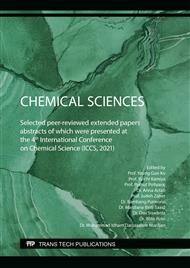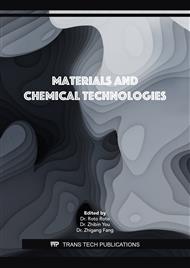p.129
p.137
p.145
p.151
p.157
p.165
p.173
p.181
p.187
Synthesis of Patchouli Acetate and Propionate from Patchouli Oil through Esterification Reaction Using Homogeneous and Heterogeneous Catalysts
Abstract:
Synthesis of patchouli acetate and propionate from patchouli oil and carboxylic acids (acetic acid and propionic acid) has been carried out through esterification reaction. The reaction was carried out at 100 °C for 3 h in the presence of homogeneous (HCl and H2SO4) and heterogeneous (activated zeolite) catalysts. The esterification products were characterized using Fourier Transform Infrared Spectrometer and Gas Chromatography-Mass Spectrometer. The results showed that the reaction using acetic acid as the acid precursor in the presence of HCl, H2SO4, and zeolite gave patchouli acetate in 42, 48, and 38%, respectively. In addition, the esterification of patchouli oil using propionic acid in the presence of HCl, H2SO4, and zeolite produced patchouli propionate in 40, 54, and 36%, respectively.
Info:
Periodical:
Pages:
157-161
Citation:
Online since:
May 2022
Price:
Сopyright:
© 2022 Trans Tech Publications Ltd. All Rights Reserved
Share:
Citation:



